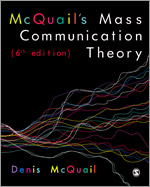
McQuail's Mass Communication Theory
- Denis McQuail - University of Amsterdam, Netherlands
SAGE Publications Ltd
| Format | Published Date | ISBN | Price |
|---|
Contributors:
Denis McQuail
Denis McQuail (1935-2017) was Emeritus Professor at the School of Communication Research (ASCOR) University of Amsterdam and Visiting Professor in the Department of Politics at the University of Southampton. He studied history and sociology at the University of Oxford and received his Ph.D. from the University of Leeds. He is an Honorary Doctor of the University of Gent. He has published widely in the field of media and communication, with particular reference to audience research, media policy and performance, and political communication. His most recent book publication is McQuail's Media and Mass Communication Theory, 7th edition., SAGE, 2020, co-authored by Mark Deuze.